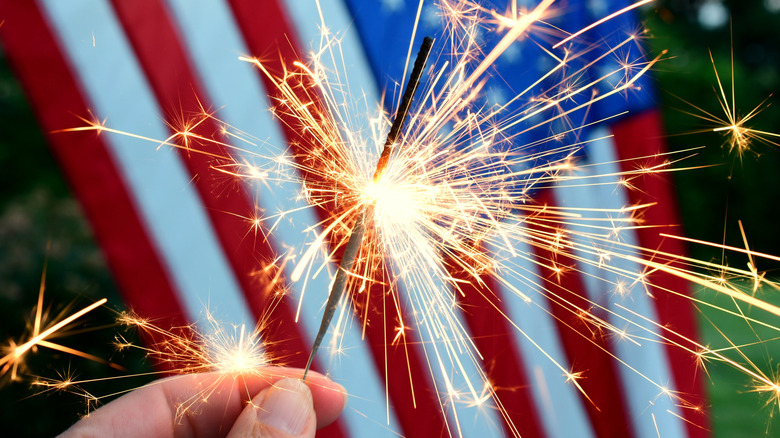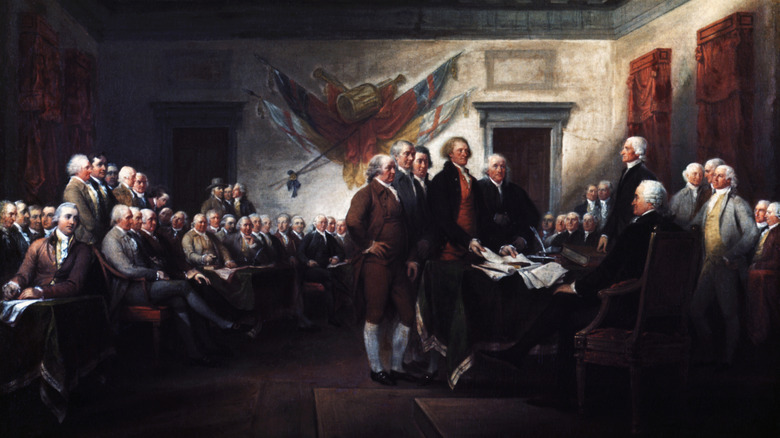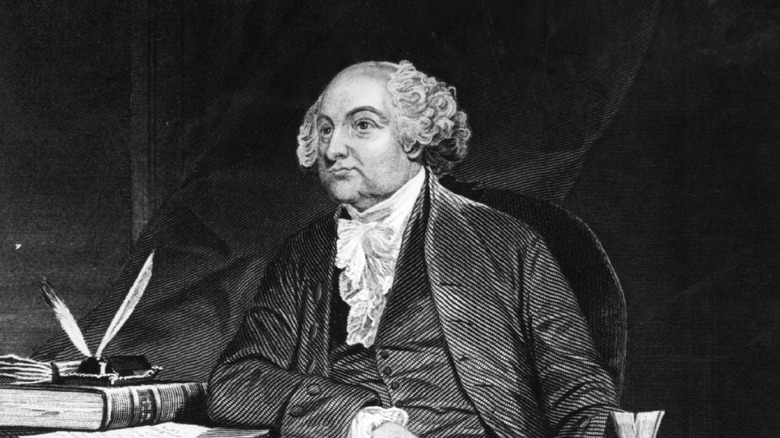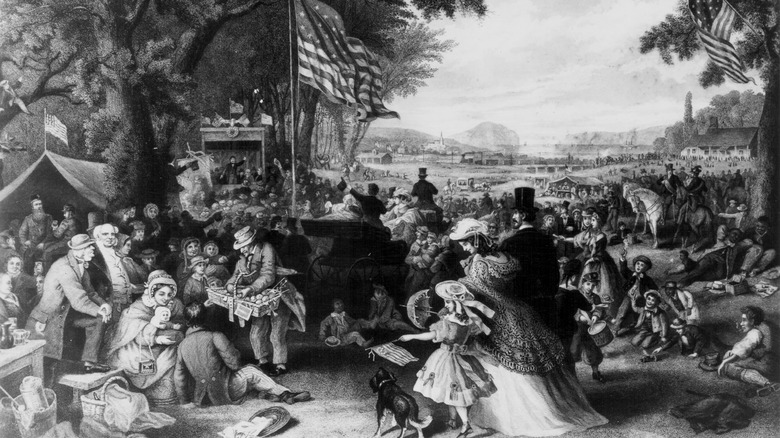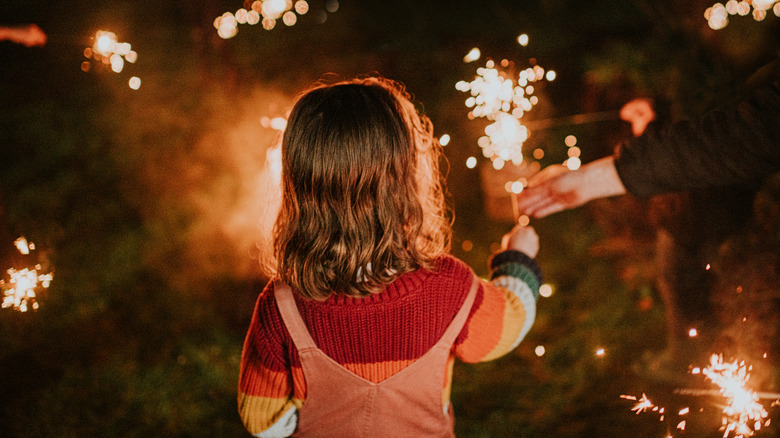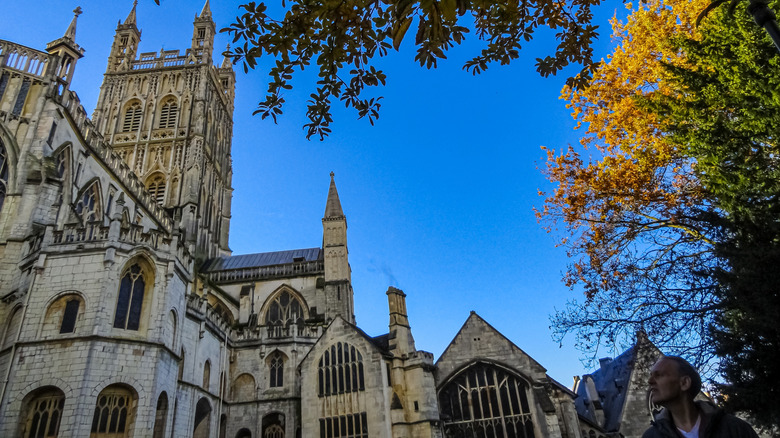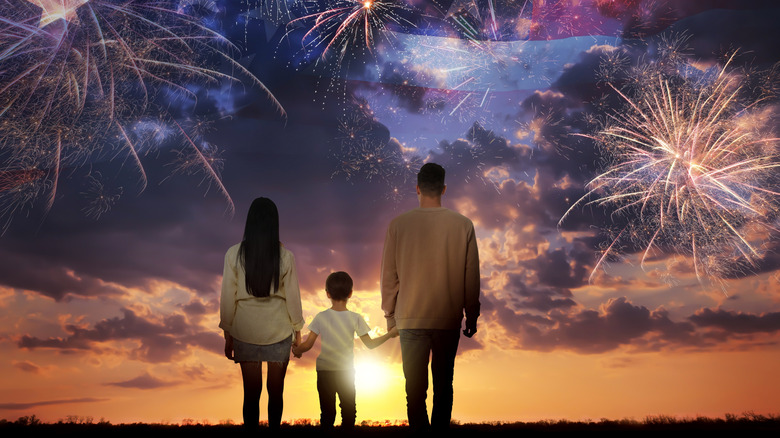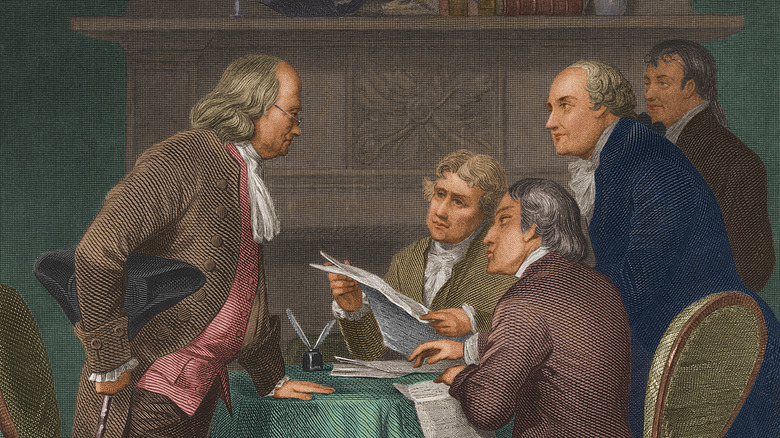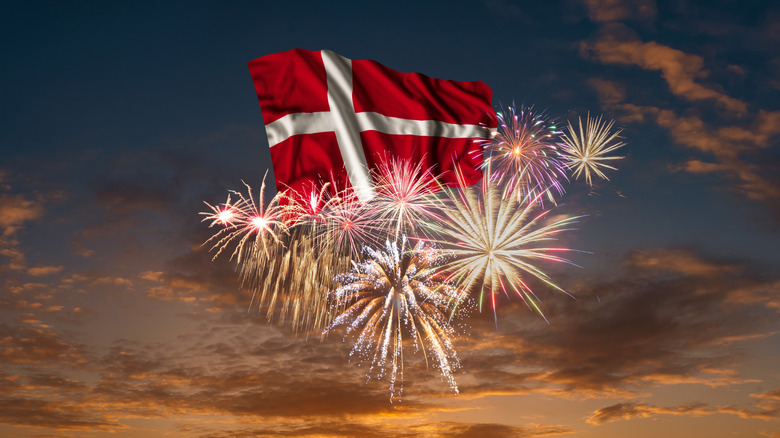Things That Don't Make Sense About The Fourth Of July
Some events are so monumental that they appear to walk that line between history and mythology, and that's definitely the case with those long summer months around America's independence. It's such a milestone in the country's history that much has been said about it, and often incorrectly. There are a ton of myths and legends that have grown up around the Founding Fathers, for instance, and when it comes to the Fourth of July, well, that's pretty straightforward, isn't it?
That's the day young America declared independence from tyrannical British overlords and went from being a colony to a fledgling country. However, when you start looking at the historical facts that have been preserved about the nation's founding, there are actually a few things that just don't make sense. That confusion has continued through a few hundred years of history, and there are some details that are enough to make you stop and say, "Wait, what?!"
We'd even go as far as to say that's true no matter how well you think you know this fan favorite American holiday. Sure, it's the stuff of long weekends, backyard BBQs, and some much-needed downtime, but at the same time, it's also a fascinating snapshot into American history and culture.
Not a heck of a lot happened on July 4, 1776, at least officially
Independence Day — the Fourth of July — is often said to commemorate America's declaration of independence, both the generic term as well as the official document. But when it comes time to look at what actually happened on which day, there wasn't much going on during July 4, 1776.
The powers-that-be actually pulled the trigger, told King George III that they'd had enough of British oversight, and were officially going for independence on July 2. (Fun fact: People like Thomas Jefferson and John Adams often get a lot of the credit, but the often-overlooked Continental Congress rep who actually spearheaded this particular part of the process was Virginia's Richard Henry Lee.)
The document that would become the Declaration of Independence went through a number of changes, and that famous image shown above? That's just a discussion of the Declaration, and it depicts events that happened back on June 28. Really, the only thing that took place on July 4 was that the Congress voted to accept the final draft they'd created. And that's it, at least sort of. Precise wording wasn't agreed upon for several more weeks, the final draft wasn't written until July 19, and the actual signing took place between August 2 and (likely) over the course of the following six months and (perhaps) finishing at some point in 1777.
John Adams thought July 2 was Independence Day
It's arguable that those who know best were the ones who were there, including John Adams. Today, John Adams is perhaps most famous for hating Alexander Hamilton, but he's also credited as being the one who realized what a big deal that moment in time independence was — and the fact that it was going to be celebrated for as long as America remained a country. He got a lot of things right, but he would undoubtedly be surprised by the date we celebrate Independence Day.
On July 3, 1776, he wrote a letter to his wife. He said (via the Massachusetts Historical Society), "This Second Day of July 1776, will be the most memorable Epocha, in the History of America. — I am apt to believe that it will be celebrated, by succeeding Generations, as the great anniversary Festival. It ought to be commemorated, as the Day of Deliverance by Solemn acts of Devotion to God Almighty."
Adams went on to predict celebrations that are pretty much what we're familiar with today, including fireworks and parades. He was so convinced that July 2 was the real Independence Day that he later refused to celebrate July 4, and wouldn't even attend Independence Day festivities. Philadelphia, at least, gets it: In 2024, the city announced that part of the country's 250th birthday celebrations was going to be July 2 festivities, planned in accordance with Adams' wishes.
The first real Independence Day festivities took place on July 8
When it comes time to go that far back in history, things get a little spotty. Still, most accounts suggest that some of the first major celebrations of independence didn't happen until days after July 4. One of the largest and most well-documented was the reading of the Declaration of Independence in New York City, which — in true New York fashion — ended with the celebratory decapitation of a statue of King George III. But that didn't happen until July 9.
In many places, the reading happened on July 8, and yes, there were a lot of impromptu parades and celebrations. In fact, accounts suggest it didn't look that much different from modern-day celebrations. People grabbed their instruments and played music, others lit bonfires, and, of course, there was gunfire.
July Fourth wasn't celebrated until 1777. Philadelphia seems to have been the center of celebrations, with ships decked out in red, white, and blue, fireworks, parades, and a 13-cannon salute. Another fun fact: Thomas Jefferson was, of course, a prolific writer. His last letter was to apologize for not being able to make it to Washington, DC, for the country's 50th Fourth of July. He did write, however (via PBS): "All eyes are opened, or opening, to the right of man ... For ourselves, let the annual return of this day forever refresh our recollections of these rights, and an undiminished devotion to them."
A paragraph condemning the slave trade was removed from the Declaration of Independence
Part of the Declaration of Independence was basically a scathing condemnation of King George III, as well as an outline of all the reasons why Britain didn't deserve the respect and allegiance of the American colonies. So far, so good, but history is messy and often hypocritical. It gets overlooked a lot, but one of the passages that Thomas Jefferson originally included involved the slave trade.
It began (via American Battlefield Trust), "[King George III] has waged a cruel war against human nature itself, violating it's most sacred rights of life & liberty in the persons of a distant people who never offended him, captivating & carrying them into slavery in another hemisphere, or to incur miserable death in their transportation thither." And yes, at the time, Jefferson's household included at least 140 enslaved persons.
He wasn't the only one of the Founding Fathers, of course, which makes it so very strange that they could condemn the British king for something they were very complicit in. Numbers are pretty shocking: At the time, 53.9% of South Carolina's population was enslaved. The passage was dropped, and while there were undoubtedly multiple reasons for that, there were also two states that refused to vote to accept independence unless it was. One? Unsurprisingly, South Carolina. And the other? Pennsylvania.
Fireworks? That's a British thing
John Adams specifically wrote that he believed Independence Day was going to be celebrated with fireworks (among plenty of other things), and he's often credited as being the one who came up with the idea in the first place. However, it's a little more complicated than that.
A huge part of American independence was freedom from British oversight and the royal family. It was kind of a big deal, which makes it strange that Adams even brought up the idea of fireworks to celebrate independence. Why? Fireworks, pyrotechnics, and as Adams called them, "Illuminations," were definitely a British thing.
Fireworks were invented a long time ago — somewhere around 200 B.C. — and today, we associate fireworks with national pride, but the very first documented time it was used to celebrate an event of national importance was in 1486. History buffs will know that's when King Henry VII married Elizabeth of York, and it set a precedent for fireworks to accompany many huge events in British history. The notorious Henry VIII loved them, Elizabeth I had someone in her court who was tasked with organizing fireworks displays, and James I handed out a knighthood to the man in charge of his fireworks. Fireworks got more and more popular as the centuries rolled on, but you can argue that Adams wasn't just picking a grand display; he was following in the footsteps of the British.
A British city sometimes celebrates the Fourth
The Fourth of July is very obviously a celebration of American independence from the British, so why on earth would a British city celebrate it? Is it in some kind of a good-riddance, tongue-in-cheek manner? Not quite, and it's an odd story.
The city in question is Gloucester, and there have been a few times that the city's cathedral has played the American national anthem on the Fourth of July. In 2020, it was done to pay tribute to the American troops stationed there with NATO's Allied Rapid Reaction Corps, which is a pretty sweet gesture. That was also 400 years since the Mayflower sailed, and the anthem was played the previous year, too, for a few reasons.
It was a trial run for the 2020 performance, and Gloucester was chosen in part because it was the home of John Stafford Smith. Smith was a professional musician, but he seems like he was a pretty fun guy, too. In the 1780s, he wrote what was, according to what Gloucester Cathedral director of music Adrian Partington told the BBC, "a little anthem they could all sing when they'd had a drink or two." That ye olde drinking song was eventually given lyrics courtesy of Francis Scott Key, and America had a national anthem.
States observed the holiday before the country did
When America ditched Britain's monarchy, they replaced it with a complicated system where both the federal government and the state government started telling people what to do. It would make sense that national independence would be celebrated on a federal level first, but that's not what happened at all. In fact, that didn't happen for a long, long time.
First, let's talk about the states. It didn't take the first one long at all to adopt the Fourth of July as a holiday, and it happened in 1781. That's when the state legislature of Massachusetts made it a state holiday, and that, at least, makes sense. Massachusetts has always been leading the way in American history, from being the landing site of the first English settlers who journeyed to the New World for a whole host of reasons, to being the site of epic conflicts like the Battle of Bunker Hill.
But here's where things get weird. The very first officially-organized, public celebration of the Fourth of July didn't happen until 1783, and it took place in Winston-Salem, North Carolina. On a federal level, the country had to wait almost 100 years: The Fourth of July wasn't a federal holiday until 1870.
Americans get hurt a lot while celebrating
There's a lot to love about the Fourth of July, but there are also a lot of Fourth of July celebrations that go horribly wrong, and it happens so often that it's considered one of the most dangerous and deadliest holidays of the year.
There are a lot of reasons for that, and the most obvious involves fireworks. There were eight fireworks-related deaths in 2023, and in that year alone, 9,700 people were sent to the emergency room with injuries that were mostly burns and head trauma. There are also a lot of people traveling for the long weekend, so there's often an increase in car accidents. Add alcohol into the mix, and it's a recipe for disaster.
However, there are a lot of other, more obscure things adding to the Independence Day injury count. Many people head to nearby beaches, parks, and pools, spend time at backyard BBQs, and bake under the hot sun for parades. Consequently, there are many instances of heat stroke, burns, food poisoning, dehydration, boating accidents, drownings, car accidents that involve pedestrians and cyclists, and even injuries from things like pickup basketball games. There are also shark attacks: It happened in 2014, and in 2024, four people on a Fourth of July swim in Texas were attacked by a shark. Safety first, people!
Presidents have a weird and morbid connection to July 4
The Fourth of July was obviously an important day to the Founding Fathers, and here's where things get weird. In later years, three of them died on July 4, and two on the exact same day, which also happened to be the 50th anniversary of that admittedly not-so-iconic July day back in 1776.
John Adams was one, and he had some incredibly ironic last words. Before he died on July 4, 1826, he reportedly said, "Thomas Jefferson survives." Adams, it turned out, died not knowing that Jefferson had predeceased him by a few hours. They both died 50 years to the day after voting to accept the Declaration of Independence, and it was Forbes who did the math to figure out the odds of that happening: a 7 in 100,000 chance.
A third Founding Father — who also happened to have served as an American president — died on July 4, 1831. That was James Monore, and the media reported on just how unusual it was. When Monroe died, the country was being helmed by the seventh president, Andrew Jackson, which meant that three of the six previous presidents died on July 4. Finally, there's one more significant date in here. July 4, 1872, was the birthday of the 30th president, Calvin Coolidge.
One of the largest Fourth of July celebrations is in Denmark
The Philippines has celebrated the Fourth of July for a long time, as it's the day it was granted independence from the U.S. It would make sense, then, that the largest Fourth of July celebrations outside of the U.S. would be there, but that's not the case. Instead, you'll need to go to Denmark.
That's where the Danish-American Friendship Association hosts a massive American Independence Day party, and they've been doing it since 1912. Festivities actually run from July 1 to 4, and include picnics, parties, live music, and the hilariously-named TopKaren Award, which is given to someone who's basically being recognized for their contributions to society. Was something lost in translation? Perhaps.
Thousands of people attend, and it all goes back to the Rebild National Park. That land was bought by a group of Danish citizens who had emigrated to the U.S., then returned to buy the land with the caveat that it host an annual friendship celebration. Over the years, it has welcomed speakers who included Walt Disney and Richard Chamberlain, as well as Danish royalty and American president Richard Nixon. There's lots of singing, some pickled herring, a lot of speeches, and a lot of friendships made between visitors who return year after year.
It has inspired a group of Polish LARPers
There are a lot of very unhappy Americans, there are a lot of overwhelmingly proud Americans, and there are a lot of people looking in from the outside in varying degrees of horror and confusion. That's where LarpVenture's Fourth of July comes in, and photos from the event went viral in 2022. That was the group of Europeans LARPing as what they perceived as ordinary Americans.
The group uses a trailer park outside of Warsaw, Poland, and every year, they role-play what's described as a social drama that's all taking place during the Fourth of July. (The event itself doesn't: In 2025, it's held between September 11 and 14.) The drama is deep, and participants play characters dealing with grief or bullying, some are trying to get into college or are being courted by gangs, and some are dealing with addiction issues.
The idea was to get a better idea of what America is really like for the majority. Those in charge researched middle America extensively and incorporated issues from a lack of healthcare to poverty, drug use, and unemployment, so it gets pretty dystopian. While many Americans might see the Fourth as a celebration of independence, it's a group in Poland that's taking a long, hard look at the dark side of the American dream.
One of the oldest traditions began as a mockery of the powers-that-be and the country's oldest military company
Most Americans have heard all the rules of respect, including things like being warned about all the mistakes you can make when you're holding an American flag. You'll hear a lot about things like showing respect to members of the military, and that's what makes it so strange that one of the oldest (and only occasionally now-celebrated) parts of Fourth of July celebrations was something that was literally created to make fun of the nation's oldest military organization.
They were called the Ancient and Honorable Artillery Company, and when they assembled, they just kind of wore whatever clothes and uniforms they happened to have on hand. By the time someone decided to make fun of them with 1850s-era parades, the organization had been around for 212 years. The so-called Antiques and Horribles parades became a Fourth of July staple, and featured grotesque, horrifying costumes — often meant to represent warped images of political figures — and they were so dark that they were sometimes held at night, and definitely included a lot of alcohol consumption.
The entire point was to mock the powers-that-be and the self-important who considered them to be in the upper echelons of society, and things could get hilariously angry. The more graphic and horrible the parade, the better, and while there are a lot of traditions we should probably get rid of, some may think that this is one we should definitely bring back.
